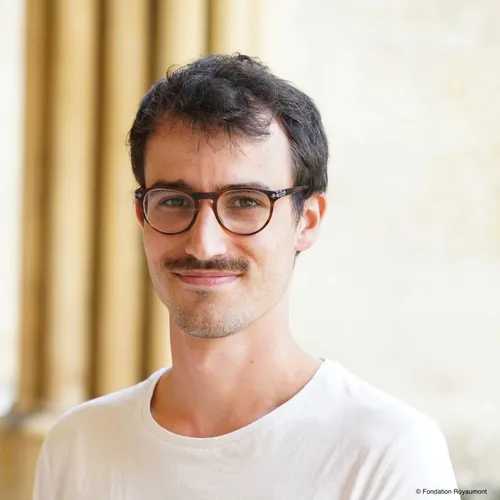
Brendan Champeaux aims to work on sound as a physical experience of listening, especially exploring the links between acoustic material, musical form, and space, volumes, architecture. He seeks singular situations where the body of the sound, its spreading and the place of its sources bring musical meaning. His field of work is large, taking interest in creation for ensemble, orchestra or soloist, as well as vocal music, organ music and electronics.
He studies composition under Jean-Luc Hervé, Gérard Pesson and Franck Bedrossian at Conservatoire de Paris (CNSMDP) and Kunstuniversität Graz (KUG), as well as new technologies applied to composition under Yan Maresz, Luin Naon and Grégoire Lorieux. His background at CNSMDP also includes 6 diplomas with distinctions (harmony, renaissance counterpoint, XXth century music, orchestration, analysis, free improvisation).
His first training in classical clarinet brings him to regularly perform as an improviser, and to integrate a strong instrumental aspect in his music, assimilating elements which were directly born in his own experience of sound production.
He works with the American poet Susan Howe (1937) in 2022, when he writes Periscope for the 20th anniversary of Exaudi vocal ensemble (broadcasted by BBC Radio 3), and in 2023-24 for an opera project. He also collaborated with Ensemble Intercontemporain, Cairn, Les Cris de Paris, TM+, Orchestre de Picardie (France), Schallfeld (Austria), the clarinettist Jérôme Voisin or the organist Thomas Lacôte; in places such as Kings Place (London), Philharmonie de Paris, Royaumont Festival.
The ensemble is divided into two groups located in distinct spaces, and which interact: on the one hand the instruments on stage, and on the other hand elements arranged around the audience, in a circle and in height. The latter are as much instruments as electronic elements, hybrids whose identity is constituted by a single sound which connects them all.
One of my obsessions has been to look for convergences between the groups that make up the ensemble: finding common points between distinct instruments, differentiated ensembles, by exploiting certain acoustic similarities, to merge them into sound blocks. This approach to volumes, both in the domain of frequencies and that of distances, or in the speech itself, makes it possible to form a perspective through acoustics, to seek depth, whether it is depth of field between sounds or depth in the sound itself.
The writing of space and its interactions makes the characterization and location of sound sources very changeable; and these spread out along the walls of the room, like the walls of a sound at the heart of which we stand – it is the room itself which becomes an instrument. In short, it’s making the place present, an actor in the work, to link listening to sound and exploration of the place.
Text translated from French.